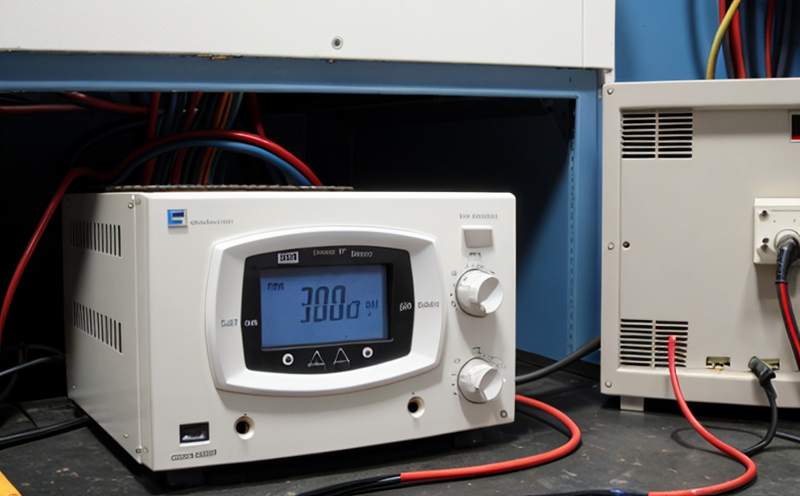IEC 61000 4-11 Voltage Dip and Short Interruption Immunity Testing of Luminaires
The IEC 61000 series of standards is designed to provide a framework for the measurement, characterization, and analysis of electromagnetic compatibility (EMC) in electrical systems. Among these standards, IEC 61000-4-11 specifically addresses the immunity of electrical and electronic equipment to voltage dips and short interruptions.
This test is crucial for ensuring that luminaires can withstand transient power quality events without failing, thereby maintaining reliability and safety in critical applications. The standard defines the test parameters necessary to simulate real-world conditions where a sudden drop or interruption in supply voltage may occur.
The methodology involves subjecting the luminaire to controlled dips and interruptions of varying depths and durations. These can range from brief interruptions (lasting 10 milliseconds) to more prolonged events extending up to several seconds. The severity levels are defined by specific percentages and durations, as detailed in the standard. Compliance with these criteria ensures that luminaires meet international requirements for robustness against voltage fluctuations.
Understanding the significance of this test requires an awareness of its critical role in safeguarding electrical installations from potential failures due to transient events. These events are common occurrences in modern power systems, particularly during switching operations or fault conditions. By adhering to IEC 61000-4-11, manufacturers ensure their products comply with global standards for reliability and safety.
The testing process involves precise control over voltage levels using specialized equipment capable of simulating real-world scenarios accurately. This ensures that the luminaire responds appropriately under all defined conditions. Additionally, it provides valuable insights into how different components within a luminaire behave during such events, enabling continuous improvement in design and manufacturing processes.
For those responsible for quality assurance or regulatory compliance, familiarity with IEC 61000-4-11 is essential. It serves as both a guidepost for product development and a benchmark against which performance can be measured reliably. Compliance also enhances market confidence by aligning with internationally recognized standards.
| Application Area | Description |
|---|---|
| Critical Infrastructure | Ensuring uninterrupted lighting in essential facilities like hospitals and data centers. |
| Sensitive Electronics | Protecting electronic devices from transient voltage events which could otherwise cause damage or malfunction. |
Scope and Methodology
The scope of IEC 61000-4-11 encompasses the evaluation of luminaire immunity to voltage dips and short interruptions. The methodology involves subjecting the luminaire to predefined transient events, which are carefully controlled to simulate real-world conditions accurately.
- Test parameters include depths and durations defined by specific percentages and time intervals.
- Equipment used for testing must be capable of generating dips and interruptions according to these specifications.
- The luminaire is exposed to a series of voltage dips and interruptions, each characterized by its depth and duration.
- Data collected during the test is analyzed to determine compliance with international standards.
Compliance ensures that luminaires can operate reliably under varied power quality conditions. This approach not only enhances product reliability but also promotes safety and efficiency in various applications.
Industry Applications
- Critical Infrastructure: Ensuring uninterrupted lighting in essential facilities like hospitals and data centers.
- Sensitive Electronics: Protecting electronic devices from transient voltage events which could otherwise cause damage or malfunction.
- Public Spaces: Maintaining visibility during power disruptions to ensure safety in densely populated areas.
The robustness of luminaires tested according to IEC 61000-4-11 is particularly important for environments where continuous operation is crucial. This includes healthcare facilities, data centers, and public spaces like airports and train stations. By adhering to these standards, manufacturers ensure their products meet global requirements for reliability and safety.
Quality and Reliability Assurance
- Compliance with IEC 61000-4-11 demonstrates that a luminaire can withstand voltage dips and interruptions without malfunctioning.
- This ensures long-term reliability, reducing the risk of failures during critical moments when power supply is most vulnerable.
Regular testing according to this standard helps identify potential issues early in the production process. This proactive approach enhances product quality by ensuring that only robust designs reach the market. Moreover, it fosters trust among customers who rely on dependable lighting solutions, especially in demanding environments where reliability is paramount.





